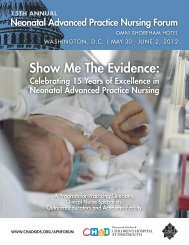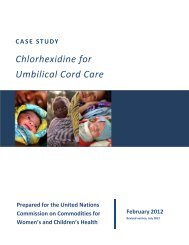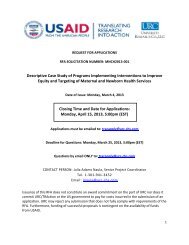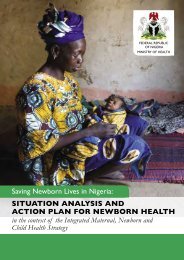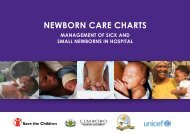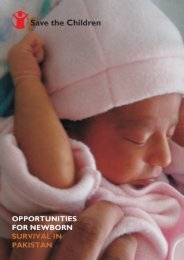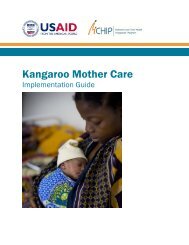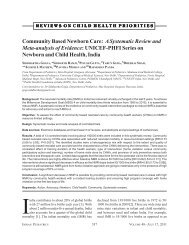Download Resource - Healthy Newborn Network
Download Resource - Healthy Newborn Network
Download Resource - Healthy Newborn Network
Create successful ePaper yourself
Turn your PDF publications into a flip-book with our unique Google optimized e-Paper software.
INTRODUCTIONBackgroundIndia contributes to around 30% of the global neonatal mortality burden. Of the 26 million babies bornevery year in India, about 1 million die before the age of one month. According to the SampleRegistration System (SRS) 2010 report, neonatal mortality contributes to more than two-thirds of allinfant deaths (NMR 33/1000 live births, IMR 47/1000 live births) and more than half of under-five deathsin the country (U-5MR 59 /1000). Though IMR has shown a steady decline over the last few years (from58/1000 in 2004 to 47 /1000 in 2010), the decline in NMR has been disproportionately slow (from37/1000 in 2004 to 33 /1000 in 2010).There is a growing recognition that in order to reduce the infant and under five mortality rates in thecountry, a significant decline in neonatal mortality is required, especially during the early neonatalperiod. Under the Janani Suraksha Yojana (JSY) scheme of the National Rural Health Mission (NRHM),there has been a significant increase in institutional deliveries. In addition, the Integrated Management ofNeonatal and Childhood Illness (IMNCI) and the Home Based <strong>Newborn</strong> Care (HBNC) programmeshave been operationalized resulting in an increasing number of sick newborns presenting to districthospitals and other referral hospitals. The Government has also established Facility Based <strong>Newborn</strong>Care (FBNC) services at different levels of health facilities to provide essential new born care and careof the sick newborns, but these services have been found to be lacking within the continuum of careespecially at the household level where many deliveries are still taking place.With rapid increase in migration and urbanization, nearly half of the country’s population is expected toreside in urban areas by the year 2030. There is an immediate need to look into the health issues of theurban population apart from the infrastructure issues. This is especially true for the urban poor sincethey are more vulnerable and worse-off than the rest of urban population, and even to the ruralpopulation for many indicators. Despite being 'considered' close to the public health facilities, theiraccess to health is severely restricted due to a number of factors – inadequate infrastructure in urbanslums, overcrowded facilities, lack of information about hospitals and services available, ineffectiveoutreach processes, weak referral system, etc.Re-analysis of the NFHS III data confirms the worse-off health status of the urban poor. The proportionof women aged 20-24 years who became mothers before age 18 was more than twice the overall urbanaverage (25.9% vs. 12.3%) and similar to the rural average of 26.6%, while mothers receiving completeANC visits was only 11% compared to overall urban average of 23.7%. More than half (56%) ofdeliveries among urban poor take place at home compared to the urban average of 32.6%. All thechildhood mortality indicators among urban poor are higher compared to the urban averages – 72.7 vs.51.9 for the U5MR, 54.6 vs. 41.7 for the IMR, and 36.8 vs. 28.7 for the NMR. Some of the childhoodindicators among urban poor are worse off than the corresponding rural indicators and these includethe proportion of children who did not receive complete immunization (60% vs. 58%) and thepercentage of under-3 children who are underweight (47% vs. 45%).In case of service delivery in the urban areas there is lack of clarity regarding ultimate responsibility ofproviding health services unlike the rural areas where the district administration is responsible for17




